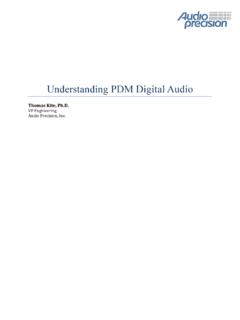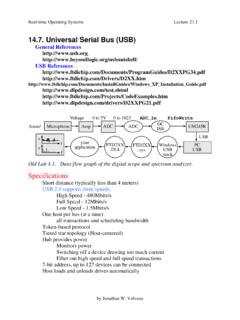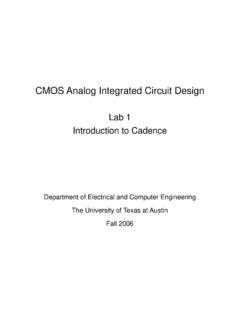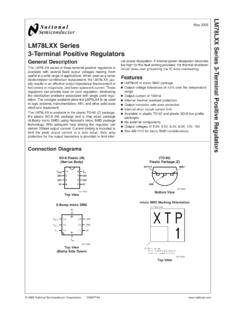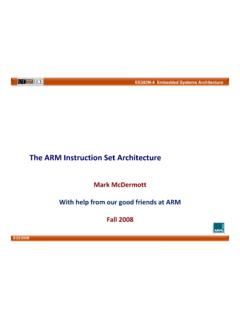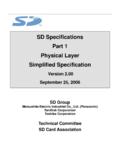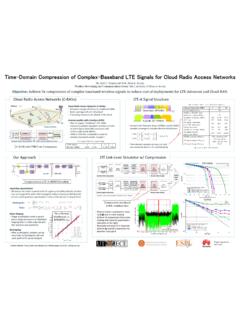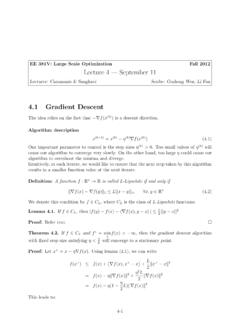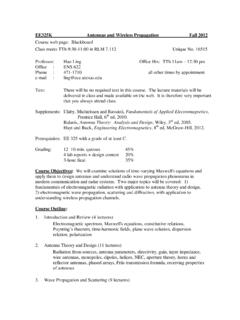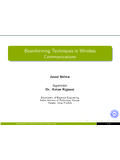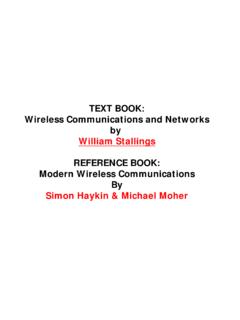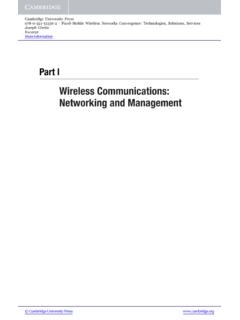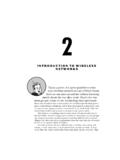Transcription of Wireless Communications Lab - University of Texas …
1 Wireless Communications LabWireless Networking and Communications GroupDepartment of Electrical and Computer Engineering The University of Texas at Austin, Austin TX USAENS W. Heath Jr. , Wednesday, September 4, 13 OutlineReview of the syllabusIntroduction to Wireless communicationA DSP approach to wirelessConnection to the labHow the course works2 Wednesday, September 4, 13 Syllabus ReviewInstructor: Robert W. Heath : Yingzhe LiEE 471C Prerequisites: EE 345S or EE 351M or EE 360K Reading Materials Based on course reader already posted to BlackboardOccasional updates to reader will be made All previous homework and exam problems in readerUndergrad: Tech area fulfillmentCommunications / Networking and Signal ProcessingGraduate.
2 Counts as a CommNetS courseClass will be video recorded but please come to class3 Wednesday, September 4, 13 OutlineReview of the syllabusIntroduction to Wireless communicationA DSP approach to wirelessConnection to the labHow the course works4 Wednesday, September 4, 13 Wireless is Everywherecellular networkslocal area networkspersonal area networksemerging applicationsWednesday, September 4, 13 The Cellular Concept6 Base stations serve multiple subscribersFrequencies are geographically reused in cellsHandoff provides seamless connectionBase Station (BS)Co-ChannelInterferenceMobile Station (MS)orUser Equipment (UE)The same frequency is reused in multiple clustersHandoffCellClusterWednesday, September 4, 13 Evolution of Cellular Systems7 First generation systems - known after the fact as 1 GConceived in the 1960 sDeployed in the late 1970 s / early 1980 sBuilt around analog technology, FM modulationLimited data, little securityExpensive due to analog technologyLittle roamingExamples AMPS, NTT, NMT-450, etc.
3 1 GMost of you in have never used 1G :-(Wednesday, September 4, 13 Evolution of Cellular Systems8 Second generation systems - known as 2 GConceived in the 1980 sDeployed in the 1990 sDigital VoiceMore subscribers per bandwidth, some dataEnabled roaming in Europe (GSM), not in US (IS-95, IS-136)Examples GSM, IS-95, IS-136, PDC, EDGE ( )2 GMost of you have a 2G compatible phoneWednesday, September 4, 13 Evolution of Cellular Systems9 Third generation systems - known as 3 GConceived in the 1990 sDeployed in the 2000 sDigital voice plus dataVideo telephonyHigher capacityCDMA (code division multiple access)Examples: 3 GPP WCDMA, HSDPA, etc. 3 GPP2 cdma2000, 1xEV, 1xEV-DO, 1xEV-DV, of you use 3G on a daily basisWednesday, September 4, 13 Evolution of Cellular Systems10 After 3G, cellular systems began fine-grained development3 GPP updates were made in stages R7, R8, R9, R10, R11, etcTransition to 4G happened at Release 10 known as 3 GPP LTE AdvancedFourth generation systems - known as 4 GIP based backbone, supports VoIPOFDMA allows efficient resource allocationMIMO (multiple antennas 8 @ base station, 4 at handset)Higher data rates3 GPP Long Term Evolution Advanced4G4G devices are now being soldHave one?)
4 Wednesday, September 4, 13 Evolution of Cellular Systems11 Fifth generation systems - known as 5G3 GPP after Release 14 will likely be considered 5 GDevelopment is ongoingPossible technologies that could make 5 GMassive MIMO - hundreds of antennas at the base stationMillimeter wave - use millimeter wave spectrum to obtain larger bandwidthNew concepts supported by 5 GDevice-to-deviceMachine-to-machineVehic le-to-vehicle5 GActive area of research, good area of senior design and PhD dissertations Wednesday, September 4, 13 Wireless is Everywherecellular networkslocal area networkspersonal area networksemerging applicationsWednesday, September 4, 13 The Wireless LAN ConceptWireless LANs provide Wireless Internet access (and LAN)Access Points (APs) serve multiple clientsUses unlicensed frequency bandsLittle to no coordination between adjacent APs13 Wednesday, September 4, 13 IEEE Wireless LANIEEE is the Institute of Electrical and Electronics EngineersMain professional society for electrical engineersEveryone should become a student member of the IEEEYou might also want to join COMSOC ( Communications society), SPSOC (signal processing society), and ITSOC (information theory society)
5 IEEE 802 is a group that develop local area network and metropolitan area network standards, focusing on the PHY, MAC, and LINK layersIEEE is WLAN working group (members develop standards + vote)14digressionWednesday, September 4, 13 IEEE : 1/2 Mbps in band, FHSS or : extend to 5 GHz ban, 54 Mbps, : (WiFi) DSSS with 11 Mbps in : similar to but for : MIMO enhancement, : Very high throughput < 6 GHz carrierMore bandwidth aggregation, more MIMO, multiuser : Very high throughput > 6 GHz carrierExploits 60 GHz unlicensed bands, lots of antennas, beamforming151111b11g11n11ac11admany more subgroups, some successful and some notDiscussion has started on beyond 11ac/adWednesday, September 4, 13 Wireless is Everywherecellular networkslocal area networkspersonal area networksemerging applicationsWednesday, September 4, 13 Personal Area Networks (PAN)Lower range connectivity compared to WLANC able replacement is one of the primary applicationsHas an ad hoc network architecture (usually called a piconet)
6 IEEE is the main standardExamples are Bluetooth used for keyboards and handsfree headsetsUpcoming uses 60 GHz for HDMI cable replacement17 Set-top Box10 Gbps6 Gbps5 GbpsPAN / LAN boundaries are blurringWednesday, September 4, 13 Wireless is Everywherecellular networkslocal area networkspersonal area networksemerging applicationsWednesday, September 4, 13 Emerging Applications19body area networkscar area networksmobile ad hoc networkspowerline communicationvehicular area networksunderwater communicationWednesday, September 4, 13 OutlineReview of the syllabusIntroduction to Wireless communicationA DSP approach to wirelessConnection to the labHow the course works20 Wednesday, September 4, 13 The network Stack21 Physical LayerMACL ogicalLinkControlNetwork LayerTransport LayerSession LayerPresentation LayerData LinkLayer Application LayerOSI network ModelAntennas & CircuitsSignal Processing AlgorithmsFocus of this classWednesday, September 4, 13 Typical Digital communication ProcessingSinkChannelDecodingDemodulatio nAnalog ProcessingtransmitterreceiverPropagation MediumSourceCodingSourceDecodingreal worldchanneldigitalanalogWednesday, September 4.
7 13 DSP Approach to Wireless23 Use systems approach for communicationInputsSystemOutputs0110110h [n]h(t)0110110timetimetimetimeWednesday, September 4, 13 Wireless Communications Lab @ UTPremises of the courseAnalog communication is no longer requiredWireless communication can be learned by all EEsWireless communication can be taught without a communication backgroundYou can implement what you learn while you learn itKey ideasLearn digital communication from a digital signal processing perspectiveIncorporate modulation, channel estimation, equalization, synchronizationUse algorithmic design examples, not comprehensive theoryLeverage flexible software defined radio prototypingExploit LabVIEW & USRP24 Developed and tested over 7 yearsEE 471C / EE 381 VWednesday.
8 September 4, 13 Technical Concepts in the CourseDSP Models for communicationSampling, up/down conversion, baseband vs. passband, complex basebandPower spectrum, bandwidth, pulse-shapingBasics of digital communicationQAM modulation, ML detectionDealing with impairmentsChannel estimationFrame/sample/carrier frequency offset synchronizationEqualization, single carrier frequency domain equalizationOFDMS tandards: GSM, IEEE , IEEE models: large scale, small scale, coherenceMultiple antennas: receive, transmit, MIMO25 Wednesday, September 4, 13 Content of the CourseDigital comm overviewSignals, stochastic processesTransforms, sampling theormFrequency response, power spectrum, bandwidthUpconversion, downconversion, complex basebandQuadrature pulse amplitude modulationOptimal pulse shapesMaximum likelihood detection in AWGNS ample timing offset, sample timing algorithmsFrequency selective channels, least squares channel estimationFrequency offset estimation and correction, frequency domain equalizationSingle carrier frequency domain equalization, OFDM, the cyclic prefixIEEE , GSM standardIntroduction to propagation, large-scale fading, link budgets.
9 Path-lossSmall-scale fading, coherence time, coherence bandwidthProbability of error in fading channelsSources of diversity, Alalmouti space-time code, maximum ratio combiningIntroduction to MIMO communication , spatial multiplexingIntroduction to MIMO-OFDM, highlights of the IEEE standard26 Mathematical preliminaries Basic digital commChannel impairmentsStandardsFadingMIMOW ednesday, September 4, 13 OutlineReview of the syllabusIntroduction to Wireless communicationA DSP approach to wirelessConnection to the labHow the course works27 Wednesday, September 4, 13 The LabLocated in ENS 113 Lab has ten workstations for transmit / receiveWork in teams of 2, same team the whole semesterUse your windows laptop to connect (need GigEthernet)28NI USRP 2921ethernet cableMIMO cableantennasWednesday, September 4, 13 How this Fits with the Lab29 SourceChannelCodingModulationD/ARF UpconversionSinkChannelDecodingDemodulat ionA/DRF Downconversionchanneltransmitterreceiver Laptop with LabVIEWNI USRP 2921 Real world(all digital signal processing)
10 Wednesday, September 4, 13 Content of the CourseDigital comm overviewSignals, stochastic processesTransforms, sampling theormFrequency response, power spectrum, bandwidthUpconversion, downconversion, complex basebandQuadrature pulse amplitude modulationOptimal pulse shapesMaximum likelihood detection in AWGNS ample timing offset, sample timing algorithmsFrequency selective channels, least squares channel estimationFrequency offset estimation and correction, frequency domain equalizationSingle carrier frequency domain equalization, OFDM, the cyclic prefixIEEE , GSM standardIntroduction to propagation, large-scale fading, link budgets, path-lossSmall-scale fading, coherence time, coherence bandwidthProbability of error in fading channelsSources of diversity, Alalmouti space-time c
